Abstract
In this article, we present an algorithm to determine the authenticity of a signature with high probability. This study addresses the increasing need for robust and accurate methods of verifying offline signatures, which are crucial in various legal and financial contexts. By combining geometric properties of curves and advanced image processing techniques, our approach effectively distinguishes between genuine and forged signatures. The core of our method utilizes multiple knot B-splines in approximation theory, mean curvature analysis, and curve fitting, providing a comprehensive framework for signature verification. Our findings demonstrate a significant improvement in accuracy over existing methods, as validated by several empirical examples. This research not only contributes to the field of signature verification but also opens avenues for future studies to enhance and adapt our algorithm for broader applications in security and authentication systems.
1 Introduction
Signature verification is a crucial task in the fields of pattern recognition and security, especially in legal, financial, and administrative contexts where the authenticity of signatures plays a pivotal role. The problem of verifying a signature can be approached in two distinct ways: offline and online verification. Online systems rely on dynamic data such as the pressure, speed, and timing of the signature during its creation, while offline systems work with static images of signatures, typically scanned after being written on the article. The focus of this research is on offline signature verification, which presents unique challenges due to the lack of dynamic information.
Numerous methods have been developed to tackle the problem of signature verification. For online systems, approaches such as writer-specific feature extraction and classifiers have been proposed. For example, an approach leveraging Gaussian mixture models was introduced by Xia et al. to align signatures for improved matching [1]. Offline systems, on the other hand, primarily rely on the structural and geometric properties of the signature itself. Zhu et al. [2] proposed a method that captures the characteristic structural saliency of the signature for detection and segmentation purposes. Similarly, Hou et al. [3] developed an image descriptor for predicting human fixation points, which has been adapted for signature verification.
In recent years, deep learning approaches have gained popularity for signature verification. Alajrami et al. [4] introduced a convolutional neural network (CNN) model for offline verification, contrasting it with online techniques. Their work, along with that of Sudharshan and Vismaya [5], who evaluated CNN architectures like VGG16, VGG19, and ResNet50, demonstrated the potential of deep learning for this task. Moreover, Abdirahman et al. [6] explored advanced deep learning models such as MobileNet, ResNet50, and YOLOv5, aiming to improve the detection of forged signatures through better preprocessing and model architecture.
Despite the progress made, offline signature verification still faces significant challenges, particularly in terms of robustness to variations in handwriting and the complexity of forgeries. Many existing methods struggle to handle the intricacies of handwritten signatures, such as subtle distortions or variations that occur naturally between different instances of a genuine signature. Moreover, traditional deep learning methods often require large amounts of training data and substantial computational resources, making them less practical for certain applications. The current methods, while effective to a certain degree, do not fully address the variability in offline signatures or the need for high accuracy in complex forgery detection. This study aims to fill this gap by introducing a novel approach that combines geometric properties of curves with advanced image processing techniques. Specifically, our method utilizes multiple knot B-splines in approximation theory, mean curvature analysis, and curve fitting to develop a comprehensive framework for signature verification. By leveraging these mathematical tools, our approach enhances the accuracy of distinguishing between genuine and forged signatures, even in cases where subtle variations exist. The validity of our results are confirmed by some examples.
2 Preliminaries
In this section, we introduce two basic concepts called skeleton of images and approximation of simple curves by b-splines, which are essential to our discussions in the next sections.
The skeleton of an image serves as a powerful tool for shape analysis. It simplifies the structure of an object by reducing its shape to a one-dimensional representation, capturing the essential geometric features while discarding the unnecessary details. This simplification facilitates various applications, including object recognition, image segmentation, and morphological operations, making the skeleton a cornerstone in the study of image topology and structure.
On the other hand, the approximation of simple curves by B-splines provides a robust framework for curve representation and manipulation. B-splines, or Basis splines, offer a flexible and mathematically sound method for approximating complex curves with a series of simpler, piecewise polynomial segments. This approach not only enhances the precision of curve modeling but also ensures smoothness and continuity, which are vital for applications in computer-aided design, animation, and geometric modeling. Together, these concepts form a foundation for advanced image processing techniques and geometric modeling, enabling more sophisticated and efficient solutions to problems in computer vision and graphics. In the following sections, we will explore the theoretical underpinnings, practical algorithms, and application scenarios for both the skeleton of images and the use of B-splines in curve approximation.
2.1 Skeleton of images
When the image of a signature is scanned on a page, usually lines or curves in the signature are saved as multi-pixel thickness. Therefore, the single-pixel skeleton of a signature can describe well the nature of it; hence, it had better consider the single-pixel skeleton of signatures. Thus, by verification of the skeletons of signature, we can evaluate the signature verification. Some techniques for skeletonization can be found in [7,8,9]. In Figure 1, some alphabet letters and their skeletons are seen.
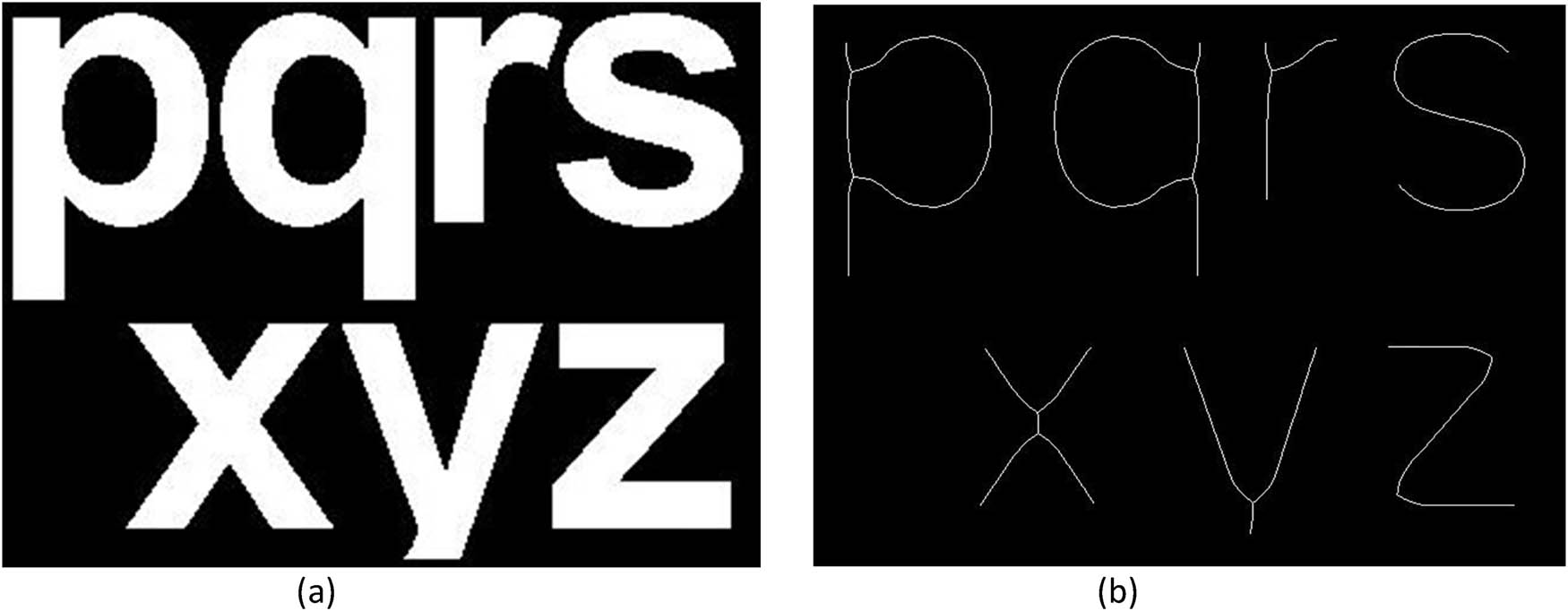
Some alphabet letters (a) and their skeletons (b).
2.2 Approximation of simple curves by b-splines
Some plane curves do not cross themselves, except probably in the end points. These curves are referred to as simple curves. A signature usually consists of some simple curves (Figure 2) that each one can be well simulated by b-splines [10,11]. Moreover, some signatures are undesirably involved small fluctuations that can be eliminated by b-splines (see Figure 7).
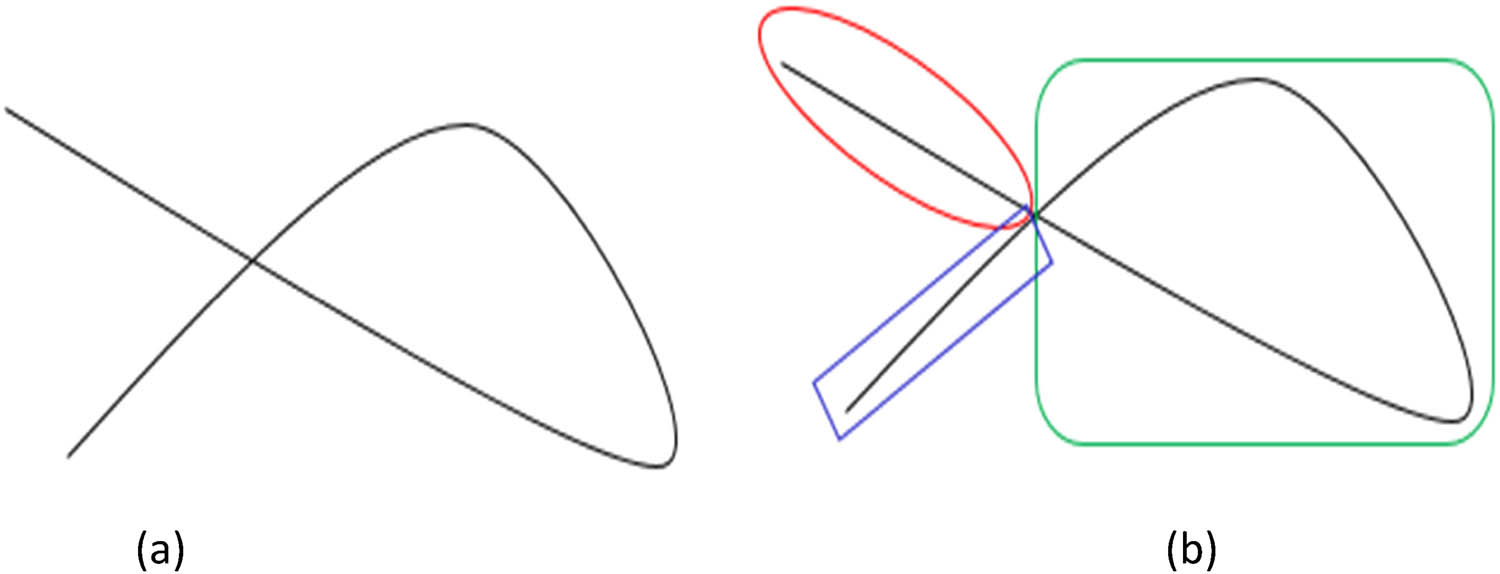
A signature (a) and its three simple curves (b).
![Figure 3
The quadratic b-spline functions defined at the knot vector
E
=
0
,
0
,
0
,
1
5
,
2
5
,
3
5
,
4
5
,
4
5
,
1
,
1
,
1
{\bf{E}}=\left\{\phantom{\rule[-0.95em]{}{0ex}},0,0,0,\frac{1}{5},\frac{2}{5},\frac{3}{5},\frac{4}{5},\frac{4}{5},1,1,1\right\}
.](/document/doi/10.1515/nleng-2024-0056/asset/graphic/j_nleng-2024-0056_fig_003.jpg)
The quadratic b-spline functions defined at the knot vector
Definition 2.1
Consider the increasing knot vector
where
and
In Figure 3, the quadratic b-spline functions are shown that are constructed on the knot vector
Explicit formulas of multiple knot b-splines for some special cases can be found in [12].
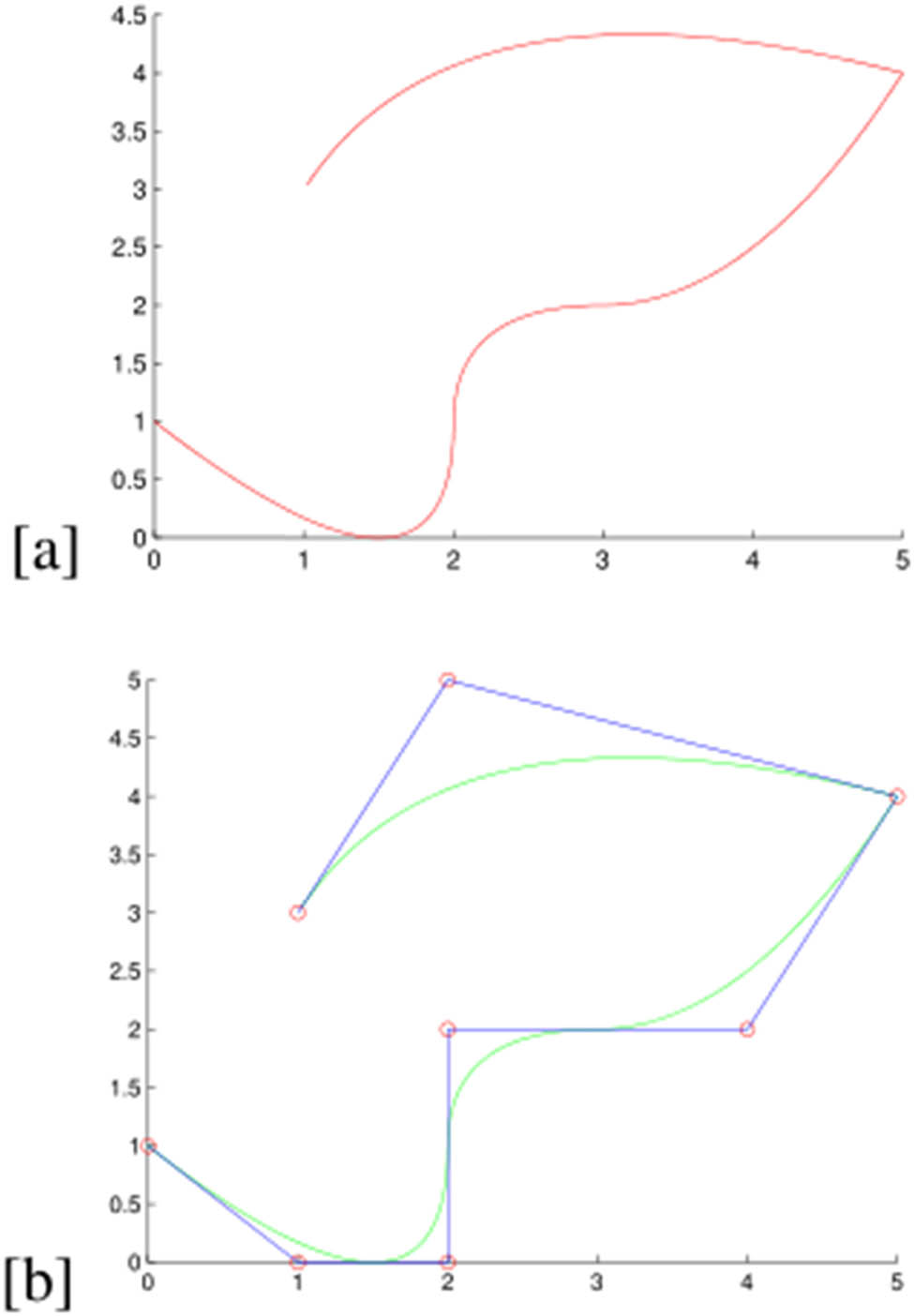
A signature (a) and its simulation by b-splines (b).
Definition 2.2
Given
where
The b-spline curves have continuous derivatives of order
To simulate a curve via isogeometry techniques with multiple knot b-spline functions, it had better use the smooth b-spline functions with smallest degree [13,14]. In Figure 4, a signature and its simulation by b-splines of order

A signature (a) and its skeleton (b).
3 Methodology of signatures
In this section, we present an algorithm called signature line recognition (SLR) and image analysis techniques (IMAT) to verify the originality of a signature. We first consider the signature as an image. Also, we assume that an original signature of per person is in access. The steps of the following algorithm should be done for genuine and questioned signatures (GQSs). To determine the linear fitting curve (LFC) of a signature curve, we fit a line
| Algorithm 1. SLR-IMAT |
|---|
| Step 1: Extract the skeleton: |
| We extract a one pixel-width skeleton of the signature image. One pixelness of the width of the skeleton saves the time to find faster the originality of the signature. |
| Step 2: Find the number of simple curves. |
| Step 3: Smooth the skeleton curve of the signature. |
| The b-spline functions and isogeometry analysis can be used to remove small fluctuations (if any) the signature. |
| Step 4: |
| (a) Let
|
| (b) Let
|
| (c) Compute the mean curvature as
|
| This step is important, because the curvature of a curve is invariant under transformation and rotation [15]. |
|
Step 5: Determine the linear fitting curve: The line
|
Theorem 3.2
[15] The linear fitting of a curve, defined in Step 5, is invariant under transformation and rotation.
The accuracy of a signature can be given by
where
Remark 3.3
in Algorithm 1, the effect of magnification on the signatures has been ignored. However, it is well known that if the magnification rate of the GQS’s is
4 Numerical experiments
In this section, by presenting some signatures, we verify their accuracy. In fact, the probability of originality for some signatures are given.
Example 4.1
Consider a genuine signature and its skeleton in Figure 5. It contains three simple curves (Figure 6). Based on Step 3, small fluctuation of the signature should be removed by b-splines (Figure 7). Next, according to Step 5, the LFC should be computed for the current genuine signature (Figure 8).
The aforementioned steps are done for both genuine (Figure 5) and questioned (Figure 9) signatures. For computing
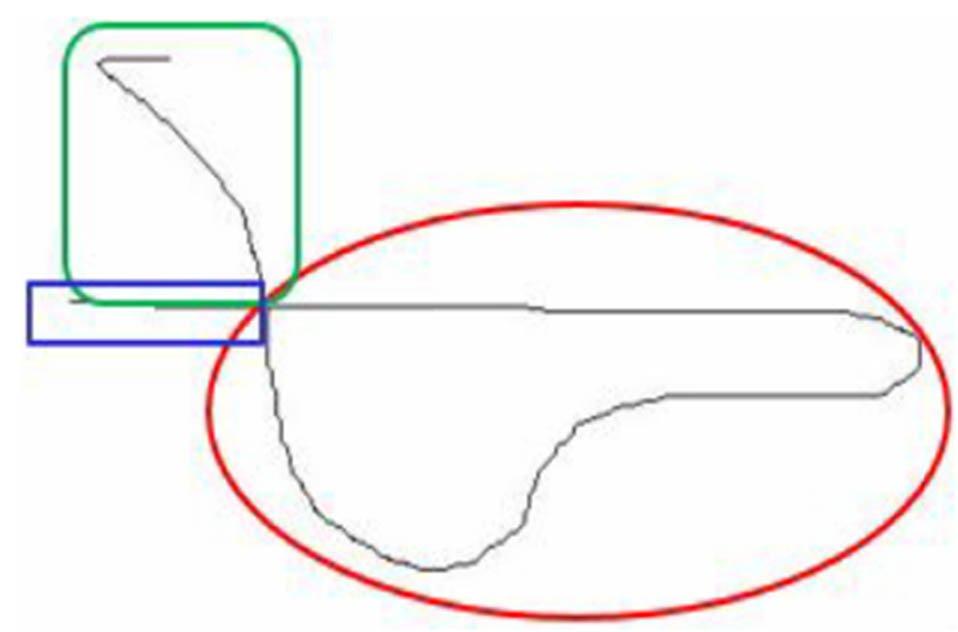
Three simple curves of a signature.

Two simple curves (a, c) and the corresponding smoothed curves (b, d).
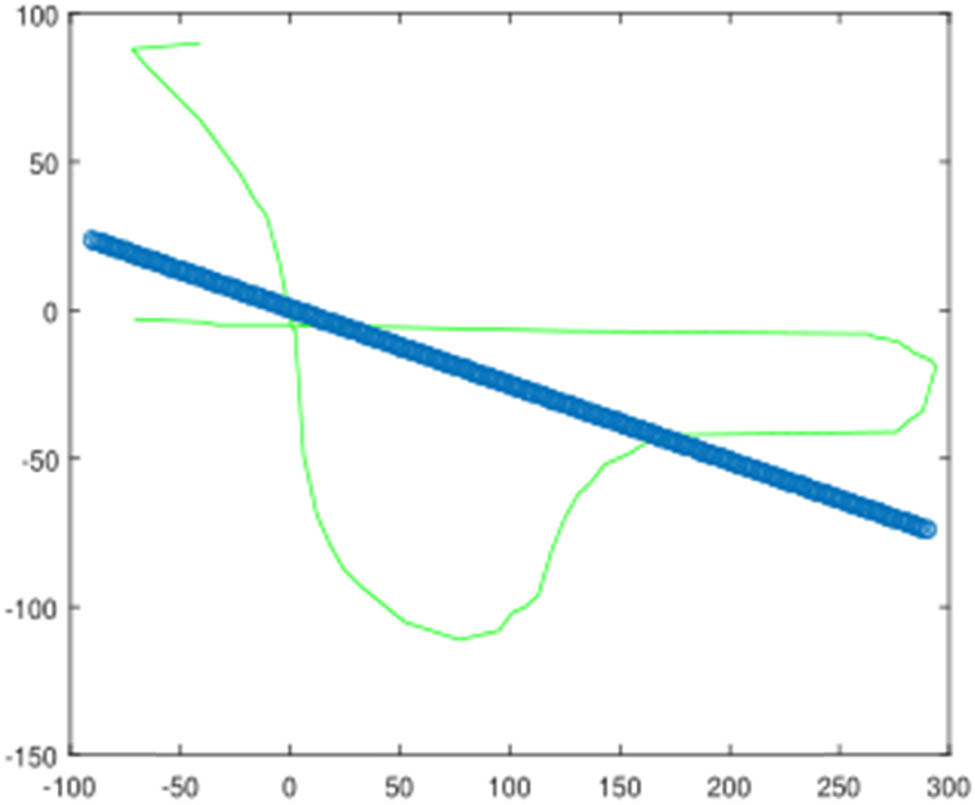
The linear fitting curve for the genuine signature given in Figure 5.
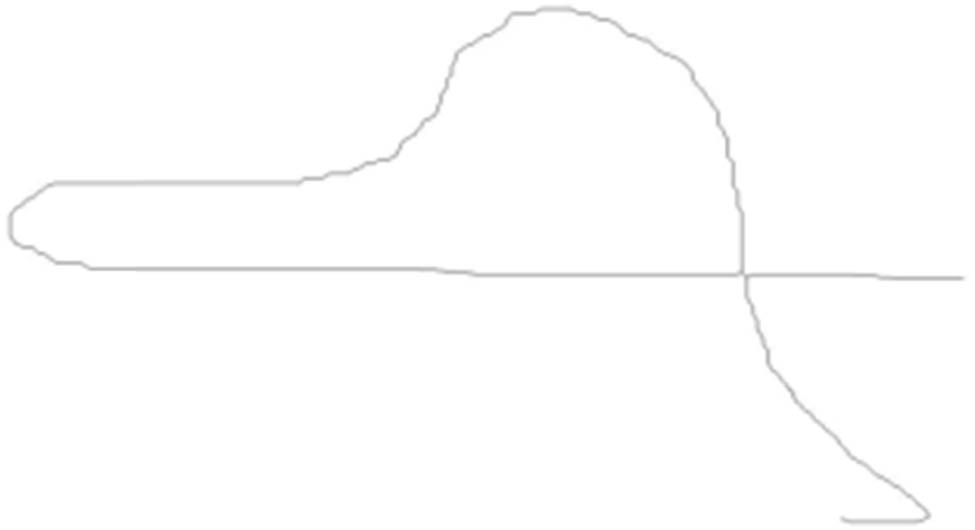
The questioned signature corresponding the genuine signature in Figure 5.
The accuracy for Example 4.1
| Genuine | Questioned |
|
|
|---|---|---|---|
| Number of simple curves | 3 | 3 | 0.9512 |
| LFC | 0.6868 | 0.3418 | |
| Mean curvature | 0.0188 | 0.0188 |
Example 4.2
In this example, we consider four genuine signatures with their corresponding questioned signatures. For all signatures the weights are taken as
The accuracy for Example 4.2
| Genuine | Questioned |
|
||
|---|---|---|---|---|
| Figures 10(a, b) | Number of simple curves | 5 | 5 | 0.9699 |
| LFC | 1.045 | 1.257 | ||
| Mean curvature | 0.339 | 0.523 | ||
| Figures 10(c, d) | Number of simple curves | 9 | 4 | 0.5225 |
| LFC | 5.065 | 1.404 | ||
| Mean curvature | 3.528 | 1.205 | ||
| Figures 10(e, f) | Number of simple curves | 9 | 9 | 0.9218 |
| LFC | 1.141 | 0.404 | ||
| Mean curvature | 1.098 | 0.205 | ||
| Figures 10(g, h) | Number of simple curves | 13 | 11 | 0.8980 |
| LFC | 0.820 | 1.146 | ||
| Mean curvature | 0.912 | 0.45 |
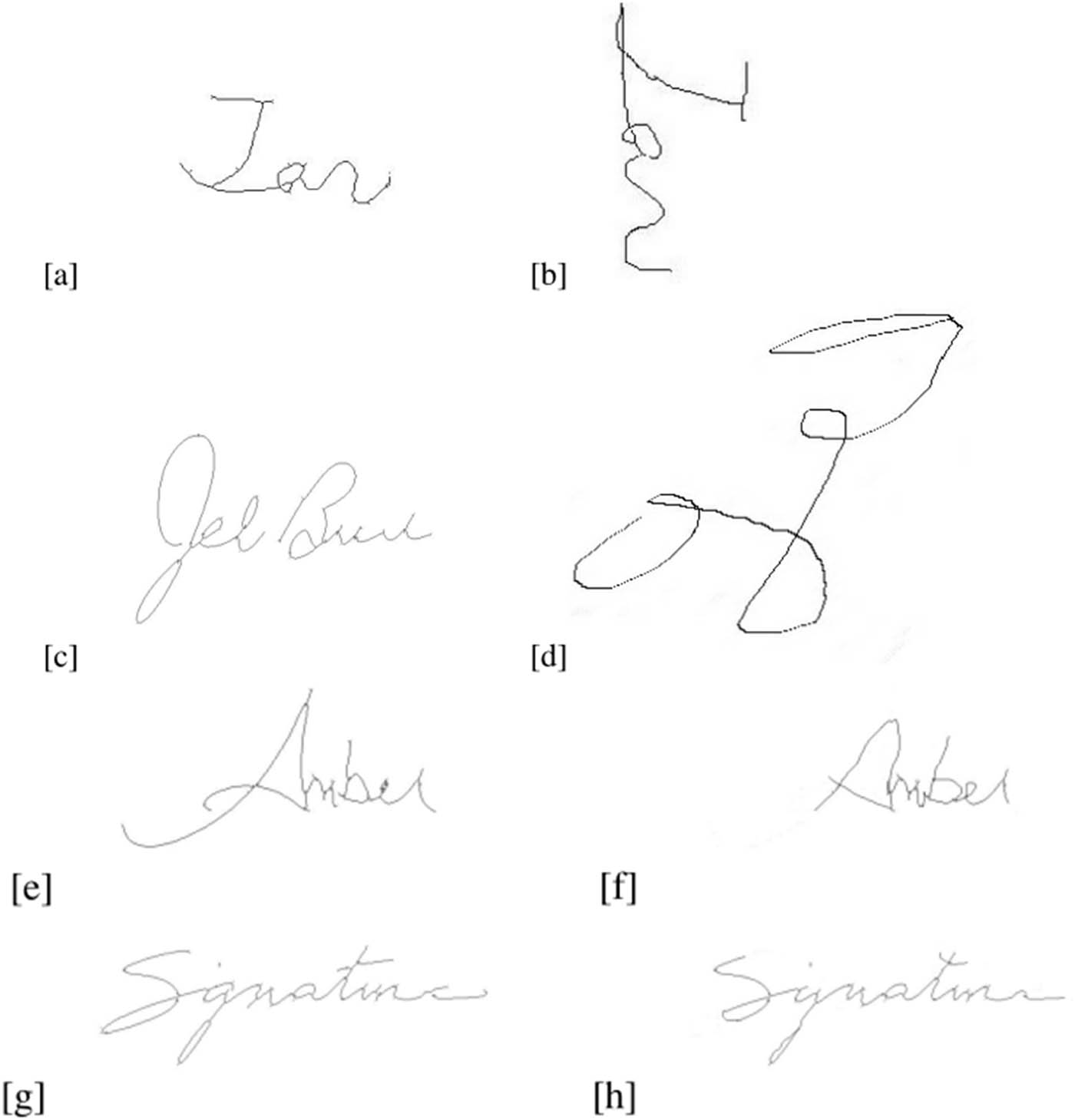
The GQS’s of the Example 4.2.
Example 4.3
For the last example, we compare our proposed method with several other methods on the database provided by [16]. This database contains 800 genuine and questioned signature images across 20 classes, with 40 signatures in each class. In this database, two criteria, the false rejection rate (FRR) and the false acceptance rate (FAR), are reported for genuine and questioned signatures, respectively. In [2,16,17], they considered the first 20 signatures in each class for training and the second 20 signatures for testing. In our case, we do not have training data, so we only consider the test signatures. The results are presented in Table 3. As can be seen, our approach, with a FRR of 0.43% and a FAR of 0.18%, shows the best offline signature verification results on this database.
5 Conclusion
In this study, we introduced a novel algorithm for verifying the authenticity of signatures with high accuracy. Our approach combines geometric properties of curves, such as the number of simple curves, LFC error, and mean curvature, with advanced image processing techniques. By leveraging multiple knot B-splines in approximation theory, we developed a robust framework that effectively distinguishes between genuine and forged signatures.
The core of our method involves analyzing the skeleton of the signature image and computing specific geometric properties to determine the accuracy of the signature. Our empirical results, as presented in Table 2, demonstrate that our algorithm significantly improves accuracy in signature verification compared to existing methods. For instance, signatures with closer metric values between genuine and questioned samples exhibited higher accuracy, indicating stronger matches.
This research contributes to the field of signature verification by providing a comprehensive and reliable method for signature authentication. The success of our algorithm in various empirical examples suggests its potential for broader applications in legal, financial, and security contexts. Furthermore, our findings open avenues for future studies to enhance and adapt our algorithm, potentially incorporating additional features or refining the current ones to further improve its effectiveness in diverse scenarios.
-
Funding information: Authors state no funding involved.
-
Author contributions: All authors contributed to the study’s conception and design. The manuscript was written, reviewed, and approved by all authors in the order presented on the first page of the manuscript.
-
Conflict of interest: The authors declare no conflicts of interest related to this research.
-
Data availability statement: All data generated or analysed during this study are included in this published article.
References
[1] Xia X, Chen Zh, Luan F Song X. Signature alignment based on GMM for on-line signature verification. Pattern Recognition. 2017;65:188–96. 10.1016/j.patcog.2016.12.019Search in Google Scholar
[2] Zhu G, Zheng Y, Doermann D, Jaeger S. Signature detection and matching for document image retrieval. IEEE Trans Pattern Anal Machine Intel. 2008;31(11):2015–31. 10.1109/TPAMI.2008.237Search in Google Scholar PubMed
[3] Hou X, Harel J, Koch C. Image signature: highlighting sparse salient regions. IEEE Trans Pattern Anal Machine Intel. 2011;34(1):194–201. 10.1109/TPAMI.2011.146Search in Google Scholar PubMed
[4] Alajrami E, Ashqar BAM, Abu-Nasser BS, Khalil AJ, Musleh MM, Barhoom AM, et al. Handwritten signature verification using deep learning. Int J Academic Multidiscipl Res. 2019;3(12):39–44. Search in Google Scholar
[5] Sudharshan DP, Vismaya RN. Handwritten signature verification system using deep learning. IEEE International Conference on Data Science and Information System (ICDSIS). Hassan, India; 2022. p. 1–5. 10.1109/ICDSIS55133.2022.9915833Search in Google Scholar
[6] Abdirahma AA, Hashi AO, Elmi MA, Rodriguez OER. Advancing handwritten signature verification through deep learning: a comprehensive study and high-precision approach. Int J Eng Trends Tech. 2024;72(4):81–91. 10.14445/22315381/IJETT-V72I4P109Search in Google Scholar
[7] Barbieri S, Meloni P, Usai F, Spano LD, Scateni R. An interactive editor for curve skeletons. Comput Graphics. 2016;60:23–33. 10.1016/j.cag.2016.08.002Search in Google Scholar
[8] Cai Y, Ming Ch, Qin Y. Skeleton extraction based on the topology and Snakes model. Results Phys. 2017;7:373–8. 10.1016/j.rinp.2016.12.026Search in Google Scholar
[9] Saha PK, Borgefors G, Baja GSD. A survey on skeletonization algorithms and their applications. Pattern Recognition Lett. 2016;76:3–12. 10.1016/j.patrec.2015.04.006Search in Google Scholar
[10] Schumaker L. Spline functions: basic theory. 3rd ed. Cambridge: Cambridge University Press; 2007. 10.1017/CBO9780511618994Search in Google Scholar
[11] Zarmehi F, Tavakoli A. Construction of the matched multiple knot B-spline wavelets on a bounded interval. Int J Comput Math. 2015;92(8):1688–714. Search in Google Scholar
[12] Esmaeili M, Tavakoli A. Construction of new multiple knot B-spline wavelets. Rocky Mountain J Math. 2017;47(5):1463–95. 10.1216/RMJ-2017-47-5-1463Search in Google Scholar
[13] Cottrell JA, Hughes TJR, Bazilevs Y. Isogeometric analysis: toward integration of CAD and FEA. John Wiley and Sons; 2009. 10.1002/9780470749081Search in Google Scholar
[14] Tavakoli A, Zarmehi F. Construction of the matched multiple knot B-spline wavelets on a bounded interval. Int J Comput Math. 2015;92(8):1688–714. 10.1080/00207160.2014.960403Search in Google Scholar
[15] Kimmel R. Numerical geometry of images: theory, algorithms, and applications. Verlag New York: Springer; 2004. 10.1007/978-0-387-21637-9Search in Google Scholar
[16] Sabourin R, Genest G, Preteux F. Off-line signature verification by local granulometric size distributions. IEEE Trans Pattern Anal Machine Intel. 1997;19(9):976–88. 10.1109/34.615447Search in Google Scholar
[17] Guo K, Doermann D, Rosenfeld A. Forgery detection by local correspondence. Int J Pattern Recognit Artif Intel. 2001;15(4):579–641. 10.1142/S0218001401001088Search in Google Scholar
[18] Shanker A, Rajagopalan A. Off-line signature verification using DTW. Pattern Recognit Lett. 2007;28(12):1407–14. 10.1016/j.patrec.2007.02.016Search in Google Scholar
© 2025 the author(s), published by De Gruyter
This work is licensed under the Creative Commons Attribution 4.0 International License.
Articles in the same Issue
- Research Articles
- Generalized (ψ,φ)-contraction to investigate Volterra integral inclusions and fractal fractional PDEs in super-metric space with numerical experiments
- Solitons in ultrasound imaging: Exploring applications and enhancements via the Westervelt equation
- Stochastic improved Simpson for solving nonlinear fractional-order systems using product integration rules
- Exploring dynamical features like bifurcation assessment, sensitivity visualization, and solitary wave solutions of the integrable Akbota equation
- Research on surface defect detection method and optimization of paper-plastic composite bag based on improved combined segmentation algorithm
- Impact the sulphur content in Iraqi crude oil on the mechanical properties and corrosion behaviour of carbon steel in various types of API 5L pipelines and ASTM 106 grade B
- Unravelling quiescent optical solitons: An exploration of the complex Ginzburg–Landau equation with nonlinear chromatic dispersion and self-phase modulation
- Perturbation-iteration approach for fractional-order logistic differential equations
- Variational formulations for the Euler and Navier–Stokes systems in fluid mechanics and related models
- Rotor response to unbalanced load and system performance considering variable bearing profile
- DeepFowl: Disease prediction from chicken excreta images using deep learning
- Channel flow of Ellis fluid due to cilia motion
- A case study of fractional-order varicella virus model to nonlinear dynamics strategy for control and prevalence
- Multi-point estimation weldment recognition and estimation of pose with data-driven robotics design
- Analysis of Hall current and nonuniform heating effects on magneto-convection between vertically aligned plates under the influence of electric and magnetic fields
- A comparative study on residual power series method and differential transform method through the time-fractional telegraph equation
- Insights from the nonlinear Schrödinger–Hirota equation with chromatic dispersion: Dynamics in fiber–optic communication
- Mathematical analysis of Jeffrey ferrofluid on stretching surface with the Darcy–Forchheimer model
- Exploring the interaction between lump, stripe and double-stripe, and periodic wave solutions of the Konopelchenko–Dubrovsky–Kaup–Kupershmidt system
- Computational investigation of tuberculosis and HIV/AIDS co-infection in fuzzy environment
- Signature verification by geometry and image processing
- Theoretical and numerical approach for quantifying sensitivity to system parameters of nonlinear systems
- Chaotic behaviors, stability, and solitary wave propagations of M-fractional LWE equation in magneto-electro-elastic circular rod
- Dynamic analysis and optimization of syphilis spread: Simulations, integrating treatment and public health interventions
- Visco-thermoelastic rectangular plate under uniform loading: A study of deflection
- Threshold dynamics and optimal control of an epidemiological smoking model
- Numerical computational model for an unsteady hybrid nanofluid flow in a porous medium past an MHD rotating sheet
- Regression prediction model of fabric brightness based on light and shadow reconstruction of layered images
- Dynamics and prevention of gemini virus infection in red chili crops studied with generalized fractional operator: Analysis and modeling
- Qualitative analysis on existence and stability of nonlinear fractional dynamic equations on time scales
- Fractional-order super-twisting sliding mode active disturbance rejection control for electro-hydraulic position servo systems
- Analytical exploration and parametric insights into optical solitons in magneto-optic waveguides: Advances in nonlinear dynamics for applied sciences
- Bifurcation dynamics and optical soliton structures in the nonlinear Schrödinger–Bopp–Podolsky system
- User profiling in university libraries by combining multi-perspective clustering algorithm and reader behavior analysis
- Review Article
- Haar wavelet collocation method for existence and numerical solutions of fourth-order integro-differential equations with bounded coefficients
- Special Issue: Nonlinear Analysis and Design of Communication Networks for IoT Applications - Part II
- Silicon-based all-optical wavelength converter for on-chip optical interconnection
- Research on a path-tracking control system of unmanned rollers based on an optimization algorithm and real-time feedback
- Analysis of the sports action recognition model based on the LSTM recurrent neural network
- Industrial robot trajectory error compensation based on enhanced transfer convolutional neural networks
- Research on IoT network performance prediction model of power grid warehouse based on nonlinear GA-BP neural network
- Interactive recommendation of social network communication between cities based on GNN and user preferences
- Application of improved P-BEM in time varying channel prediction in 5G high-speed mobile communication system
- Construction of a BIM smart building collaborative design model combining the Internet of Things
- Optimizing malicious website prediction: An advanced XGBoost-based machine learning model
- Economic operation analysis of the power grid combining communication network and distributed optimization algorithm
- Sports video temporal action detection technology based on an improved MSST algorithm
- Internet of things data security and privacy protection based on improved federated learning
- Enterprise power emission reduction technology based on the LSTM–SVM model
- Construction of multi-style face models based on artistic image generation algorithms
- Research and application of interactive digital twin monitoring system for photovoltaic power station based on global perception
- Special Issue: Decision and Control in Nonlinear Systems - Part II
- Animation video frame prediction based on ConvGRU fine-grained synthesis flow
- Application of GGNN inference propagation model for martial art intensity evaluation
- Benefit evaluation of building energy-saving renovation projects based on BWM weighting method
- Deep neural network application in real-time economic dispatch and frequency control of microgrids
- Real-time force/position control of soft growing robots: A data-driven model predictive approach
- Mechanical product design and manufacturing system based on CNN and server optimization algorithm
- Application of finite element analysis in the formal analysis of ancient architectural plaque section
- Research on territorial spatial planning based on data mining and geographic information visualization
- Fault diagnosis of agricultural sprinkler irrigation machinery equipment based on machine vision
- Closure technology of large span steel truss arch bridge with temporarily fixed edge supports
- Intelligent accounting question-answering robot based on a large language model and knowledge graph
- Analysis of manufacturing and retailer blockchain decision based on resource recyclability
- Flexible manufacturing workshop mechanical processing and product scheduling algorithm based on MES
- Exploration of indoor environment perception and design model based on virtual reality technology
- Tennis automatic ball-picking robot based on image object detection and positioning technology
- A new CNN deep learning model for computer-intelligent color matching
- Design of AR-based general computer technology experiment demonstration platform
- Indoor environment monitoring method based on the fusion of audio recognition and video patrol features
- Health condition prediction method of the computer numerical control machine tool parts by ensembling digital twins and improved LSTM networks
- Establishment of a green degree evaluation model for wall materials based on lifecycle
- Quantitative evaluation of college music teaching pronunciation based on nonlinear feature extraction
- Multi-index nonlinear robust virtual synchronous generator control method for microgrid inverters
- Manufacturing engineering production line scheduling management technology integrating availability constraints and heuristic rules
- Analysis of digital intelligent financial audit system based on improved BiLSTM neural network
- Attention community discovery model applied to complex network information analysis
- A neural collaborative filtering recommendation algorithm based on attention mechanism and contrastive learning
- Rehabilitation training method for motor dysfunction based on video stream matching
- Research on façade design for cold-region buildings based on artificial neural networks and parametric modeling techniques
- Intelligent implementation of muscle strain identification algorithm in Mi health exercise induced waist muscle strain
- Optimization design of urban rainwater and flood drainage system based on SWMM
- Improved GA for construction progress and cost management in construction projects
- Evaluation and prediction of SVM parameters in engineering cost based on random forest hybrid optimization
- Museum intelligent warning system based on wireless data module
- Optimization design and research of mechatronics based on torque motor control algorithm
- Special Issue: Nonlinear Engineering’s significance in Materials Science
- Experimental research on the degradation of chemical industrial wastewater by combined hydrodynamic cavitation based on nonlinear dynamic model
- Study on low-cycle fatigue life of nickel-based superalloy GH4586 at various temperatures
- Some results of solutions to neutral stochastic functional operator-differential equations
- Ultrasonic cavitation did not occur in high-pressure CO2 liquid
- Research on the performance of a novel type of cemented filler material for coal mine opening and filling
- Testing of recycled fine aggregate concrete’s mechanical properties using recycled fine aggregate concrete and research on technology for highway construction
- A modified fuzzy TOPSIS approach for the condition assessment of existing bridges
- Nonlinear structural and vibration analysis of straddle monorail pantograph under random excitations
- Achieving high efficiency and stability in blue OLEDs: Role of wide-gap hosts and emitter interactions
- Construction of teaching quality evaluation model of online dance teaching course based on improved PSO-BPNN
- Enhanced electrical conductivity and electromagnetic shielding properties of multi-component polymer/graphite nanocomposites prepared by solid-state shear milling
- Optimization of thermal characteristics of buried composite phase-change energy storage walls based on nonlinear engineering methods
- A higher-performance big data-based movie recommendation system
- Nonlinear impact of minimum wage on labor employment in China
- Nonlinear comprehensive evaluation method based on information entropy and discrimination optimization
- Application of numerical calculation methods in stability analysis of pile foundation under complex foundation conditions
- Research on the contribution of shale gas development and utilization in Sichuan Province to carbon peak based on the PSA process
- Characteristics of tight oil reservoirs and their impact on seepage flow from a nonlinear engineering perspective
- Nonlinear deformation decomposition and mode identification of plane structures via orthogonal theory
- Numerical simulation of damage mechanism in rock with cracks impacted by self-excited pulsed jet based on SPH-FEM coupling method: The perspective of nonlinear engineering and materials science
- Cross-scale modeling and collaborative optimization of ethanol-catalyzed coupling to produce C4 olefins: Nonlinear modeling and collaborative optimization strategies
- Unequal width T-node stress concentration factor analysis of stiffened rectangular steel pipe concrete
- Special Issue: Advances in Nonlinear Dynamics and Control
- Development of a cognitive blood glucose–insulin control strategy design for a nonlinear diabetic patient model
- Big data-based optimized model of building design in the context of rural revitalization
- Multi-UAV assisted air-to-ground data collection for ground sensors with unknown positions
- Design of urban and rural elderly care public areas integrating person-environment fit theory
- Application of lossless signal transmission technology in piano timbre recognition
- Application of improved GA in optimizing rural tourism routes
- Architectural animation generation system based on AL-GAN algorithm
- Advanced sentiment analysis in online shopping: Implementing LSTM models analyzing E-commerce user sentiments
- Intelligent recommendation algorithm for piano tracks based on the CNN model
- Visualization of large-scale user association feature data based on a nonlinear dimensionality reduction method
- Low-carbon economic optimization of microgrid clusters based on an energy interaction operation strategy
- Optimization effect of video data extraction and search based on Faster-RCNN hybrid model on intelligent information systems
- Construction of image segmentation system combining TC and swarm intelligence algorithm
- Particle swarm optimization and fuzzy C-means clustering algorithm for the adhesive layer defect detection
- Optimization of student learning status by instructional intervention decision-making techniques incorporating reinforcement learning
- Fuzzy model-based stabilization control and state estimation of nonlinear systems
- Optimization of distribution network scheduling based on BA and photovoltaic uncertainty
- Tai Chi movement segmentation and recognition on the grounds of multi-sensor data fusion and the DBSCAN algorithm
- Special Issue: Dynamic Engineering and Control Methods for the Nonlinear Systems - Part III
- Generalized numerical RKM method for solving sixth-order fractional partial differential equations
Articles in the same Issue
- Research Articles
- Generalized (ψ,φ)-contraction to investigate Volterra integral inclusions and fractal fractional PDEs in super-metric space with numerical experiments
- Solitons in ultrasound imaging: Exploring applications and enhancements via the Westervelt equation
- Stochastic improved Simpson for solving nonlinear fractional-order systems using product integration rules
- Exploring dynamical features like bifurcation assessment, sensitivity visualization, and solitary wave solutions of the integrable Akbota equation
- Research on surface defect detection method and optimization of paper-plastic composite bag based on improved combined segmentation algorithm
- Impact the sulphur content in Iraqi crude oil on the mechanical properties and corrosion behaviour of carbon steel in various types of API 5L pipelines and ASTM 106 grade B
- Unravelling quiescent optical solitons: An exploration of the complex Ginzburg–Landau equation with nonlinear chromatic dispersion and self-phase modulation
- Perturbation-iteration approach for fractional-order logistic differential equations
- Variational formulations for the Euler and Navier–Stokes systems in fluid mechanics and related models
- Rotor response to unbalanced load and system performance considering variable bearing profile
- DeepFowl: Disease prediction from chicken excreta images using deep learning
- Channel flow of Ellis fluid due to cilia motion
- A case study of fractional-order varicella virus model to nonlinear dynamics strategy for control and prevalence
- Multi-point estimation weldment recognition and estimation of pose with data-driven robotics design
- Analysis of Hall current and nonuniform heating effects on magneto-convection between vertically aligned plates under the influence of electric and magnetic fields
- A comparative study on residual power series method and differential transform method through the time-fractional telegraph equation
- Insights from the nonlinear Schrödinger–Hirota equation with chromatic dispersion: Dynamics in fiber–optic communication
- Mathematical analysis of Jeffrey ferrofluid on stretching surface with the Darcy–Forchheimer model
- Exploring the interaction between lump, stripe and double-stripe, and periodic wave solutions of the Konopelchenko–Dubrovsky–Kaup–Kupershmidt system
- Computational investigation of tuberculosis and HIV/AIDS co-infection in fuzzy environment
- Signature verification by geometry and image processing
- Theoretical and numerical approach for quantifying sensitivity to system parameters of nonlinear systems
- Chaotic behaviors, stability, and solitary wave propagations of M-fractional LWE equation in magneto-electro-elastic circular rod
- Dynamic analysis and optimization of syphilis spread: Simulations, integrating treatment and public health interventions
- Visco-thermoelastic rectangular plate under uniform loading: A study of deflection
- Threshold dynamics and optimal control of an epidemiological smoking model
- Numerical computational model for an unsteady hybrid nanofluid flow in a porous medium past an MHD rotating sheet
- Regression prediction model of fabric brightness based on light and shadow reconstruction of layered images
- Dynamics and prevention of gemini virus infection in red chili crops studied with generalized fractional operator: Analysis and modeling
- Qualitative analysis on existence and stability of nonlinear fractional dynamic equations on time scales
- Fractional-order super-twisting sliding mode active disturbance rejection control for electro-hydraulic position servo systems
- Analytical exploration and parametric insights into optical solitons in magneto-optic waveguides: Advances in nonlinear dynamics for applied sciences
- Bifurcation dynamics and optical soliton structures in the nonlinear Schrödinger–Bopp–Podolsky system
- User profiling in university libraries by combining multi-perspective clustering algorithm and reader behavior analysis
- Review Article
- Haar wavelet collocation method for existence and numerical solutions of fourth-order integro-differential equations with bounded coefficients
- Special Issue: Nonlinear Analysis and Design of Communication Networks for IoT Applications - Part II
- Silicon-based all-optical wavelength converter for on-chip optical interconnection
- Research on a path-tracking control system of unmanned rollers based on an optimization algorithm and real-time feedback
- Analysis of the sports action recognition model based on the LSTM recurrent neural network
- Industrial robot trajectory error compensation based on enhanced transfer convolutional neural networks
- Research on IoT network performance prediction model of power grid warehouse based on nonlinear GA-BP neural network
- Interactive recommendation of social network communication between cities based on GNN and user preferences
- Application of improved P-BEM in time varying channel prediction in 5G high-speed mobile communication system
- Construction of a BIM smart building collaborative design model combining the Internet of Things
- Optimizing malicious website prediction: An advanced XGBoost-based machine learning model
- Economic operation analysis of the power grid combining communication network and distributed optimization algorithm
- Sports video temporal action detection technology based on an improved MSST algorithm
- Internet of things data security and privacy protection based on improved federated learning
- Enterprise power emission reduction technology based on the LSTM–SVM model
- Construction of multi-style face models based on artistic image generation algorithms
- Research and application of interactive digital twin monitoring system for photovoltaic power station based on global perception
- Special Issue: Decision and Control in Nonlinear Systems - Part II
- Animation video frame prediction based on ConvGRU fine-grained synthesis flow
- Application of GGNN inference propagation model for martial art intensity evaluation
- Benefit evaluation of building energy-saving renovation projects based on BWM weighting method
- Deep neural network application in real-time economic dispatch and frequency control of microgrids
- Real-time force/position control of soft growing robots: A data-driven model predictive approach
- Mechanical product design and manufacturing system based on CNN and server optimization algorithm
- Application of finite element analysis in the formal analysis of ancient architectural plaque section
- Research on territorial spatial planning based on data mining and geographic information visualization
- Fault diagnosis of agricultural sprinkler irrigation machinery equipment based on machine vision
- Closure technology of large span steel truss arch bridge with temporarily fixed edge supports
- Intelligent accounting question-answering robot based on a large language model and knowledge graph
- Analysis of manufacturing and retailer blockchain decision based on resource recyclability
- Flexible manufacturing workshop mechanical processing and product scheduling algorithm based on MES
- Exploration of indoor environment perception and design model based on virtual reality technology
- Tennis automatic ball-picking robot based on image object detection and positioning technology
- A new CNN deep learning model for computer-intelligent color matching
- Design of AR-based general computer technology experiment demonstration platform
- Indoor environment monitoring method based on the fusion of audio recognition and video patrol features
- Health condition prediction method of the computer numerical control machine tool parts by ensembling digital twins and improved LSTM networks
- Establishment of a green degree evaluation model for wall materials based on lifecycle
- Quantitative evaluation of college music teaching pronunciation based on nonlinear feature extraction
- Multi-index nonlinear robust virtual synchronous generator control method for microgrid inverters
- Manufacturing engineering production line scheduling management technology integrating availability constraints and heuristic rules
- Analysis of digital intelligent financial audit system based on improved BiLSTM neural network
- Attention community discovery model applied to complex network information analysis
- A neural collaborative filtering recommendation algorithm based on attention mechanism and contrastive learning
- Rehabilitation training method for motor dysfunction based on video stream matching
- Research on façade design for cold-region buildings based on artificial neural networks and parametric modeling techniques
- Intelligent implementation of muscle strain identification algorithm in Mi health exercise induced waist muscle strain
- Optimization design of urban rainwater and flood drainage system based on SWMM
- Improved GA for construction progress and cost management in construction projects
- Evaluation and prediction of SVM parameters in engineering cost based on random forest hybrid optimization
- Museum intelligent warning system based on wireless data module
- Optimization design and research of mechatronics based on torque motor control algorithm
- Special Issue: Nonlinear Engineering’s significance in Materials Science
- Experimental research on the degradation of chemical industrial wastewater by combined hydrodynamic cavitation based on nonlinear dynamic model
- Study on low-cycle fatigue life of nickel-based superalloy GH4586 at various temperatures
- Some results of solutions to neutral stochastic functional operator-differential equations
- Ultrasonic cavitation did not occur in high-pressure CO2 liquid
- Research on the performance of a novel type of cemented filler material for coal mine opening and filling
- Testing of recycled fine aggregate concrete’s mechanical properties using recycled fine aggregate concrete and research on technology for highway construction
- A modified fuzzy TOPSIS approach for the condition assessment of existing bridges
- Nonlinear structural and vibration analysis of straddle monorail pantograph under random excitations
- Achieving high efficiency and stability in blue OLEDs: Role of wide-gap hosts and emitter interactions
- Construction of teaching quality evaluation model of online dance teaching course based on improved PSO-BPNN
- Enhanced electrical conductivity and electromagnetic shielding properties of multi-component polymer/graphite nanocomposites prepared by solid-state shear milling
- Optimization of thermal characteristics of buried composite phase-change energy storage walls based on nonlinear engineering methods
- A higher-performance big data-based movie recommendation system
- Nonlinear impact of minimum wage on labor employment in China
- Nonlinear comprehensive evaluation method based on information entropy and discrimination optimization
- Application of numerical calculation methods in stability analysis of pile foundation under complex foundation conditions
- Research on the contribution of shale gas development and utilization in Sichuan Province to carbon peak based on the PSA process
- Characteristics of tight oil reservoirs and their impact on seepage flow from a nonlinear engineering perspective
- Nonlinear deformation decomposition and mode identification of plane structures via orthogonal theory
- Numerical simulation of damage mechanism in rock with cracks impacted by self-excited pulsed jet based on SPH-FEM coupling method: The perspective of nonlinear engineering and materials science
- Cross-scale modeling and collaborative optimization of ethanol-catalyzed coupling to produce C4 olefins: Nonlinear modeling and collaborative optimization strategies
- Unequal width T-node stress concentration factor analysis of stiffened rectangular steel pipe concrete
- Special Issue: Advances in Nonlinear Dynamics and Control
- Development of a cognitive blood glucose–insulin control strategy design for a nonlinear diabetic patient model
- Big data-based optimized model of building design in the context of rural revitalization
- Multi-UAV assisted air-to-ground data collection for ground sensors with unknown positions
- Design of urban and rural elderly care public areas integrating person-environment fit theory
- Application of lossless signal transmission technology in piano timbre recognition
- Application of improved GA in optimizing rural tourism routes
- Architectural animation generation system based on AL-GAN algorithm
- Advanced sentiment analysis in online shopping: Implementing LSTM models analyzing E-commerce user sentiments
- Intelligent recommendation algorithm for piano tracks based on the CNN model
- Visualization of large-scale user association feature data based on a nonlinear dimensionality reduction method
- Low-carbon economic optimization of microgrid clusters based on an energy interaction operation strategy
- Optimization effect of video data extraction and search based on Faster-RCNN hybrid model on intelligent information systems
- Construction of image segmentation system combining TC and swarm intelligence algorithm
- Particle swarm optimization and fuzzy C-means clustering algorithm for the adhesive layer defect detection
- Optimization of student learning status by instructional intervention decision-making techniques incorporating reinforcement learning
- Fuzzy model-based stabilization control and state estimation of nonlinear systems
- Optimization of distribution network scheduling based on BA and photovoltaic uncertainty
- Tai Chi movement segmentation and recognition on the grounds of multi-sensor data fusion and the DBSCAN algorithm
- Special Issue: Dynamic Engineering and Control Methods for the Nonlinear Systems - Part III
- Generalized numerical RKM method for solving sixth-order fractional partial differential equations

